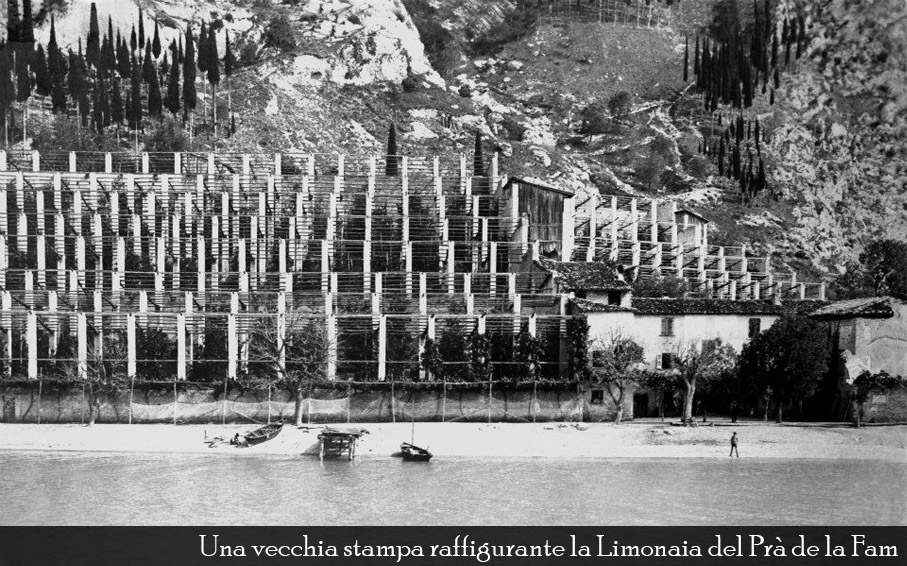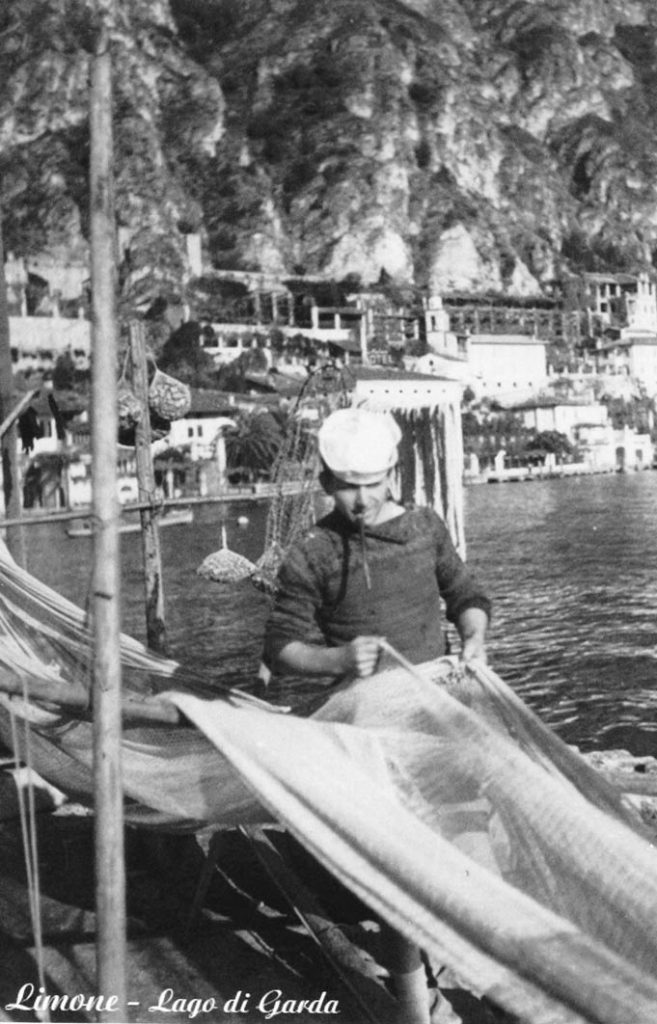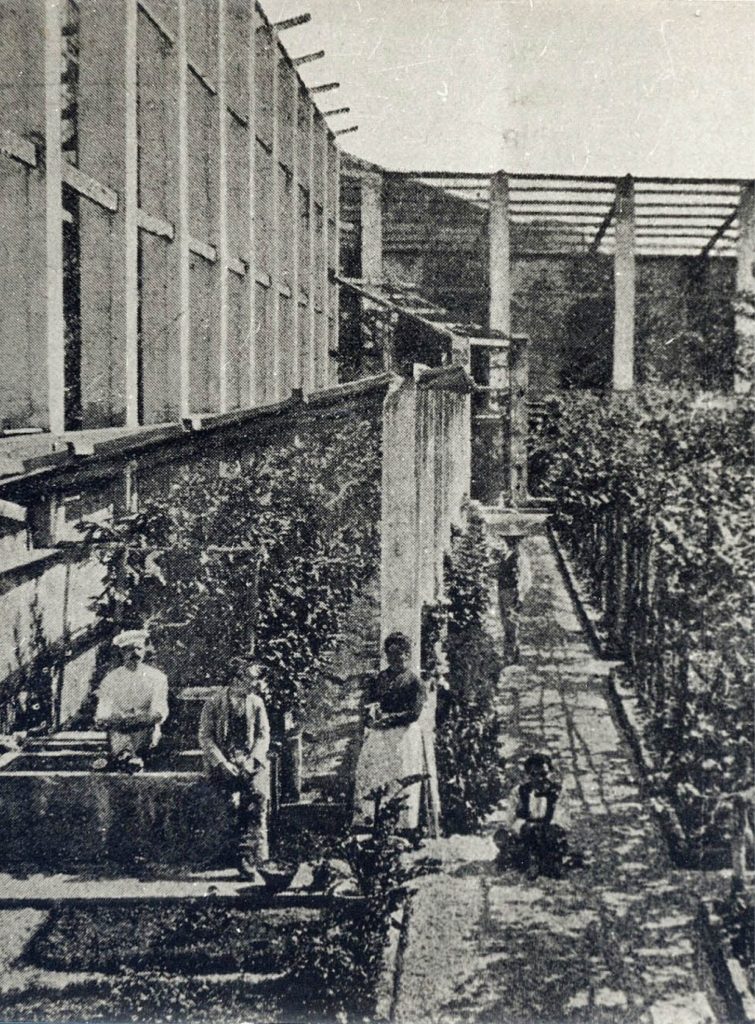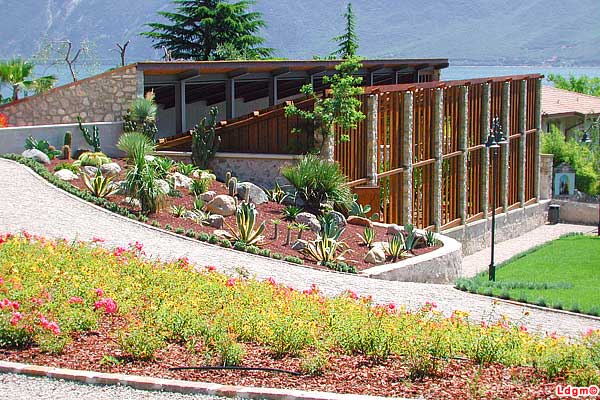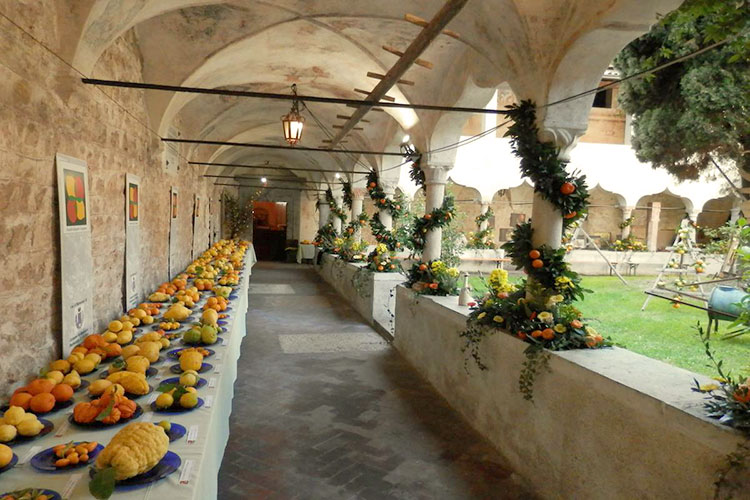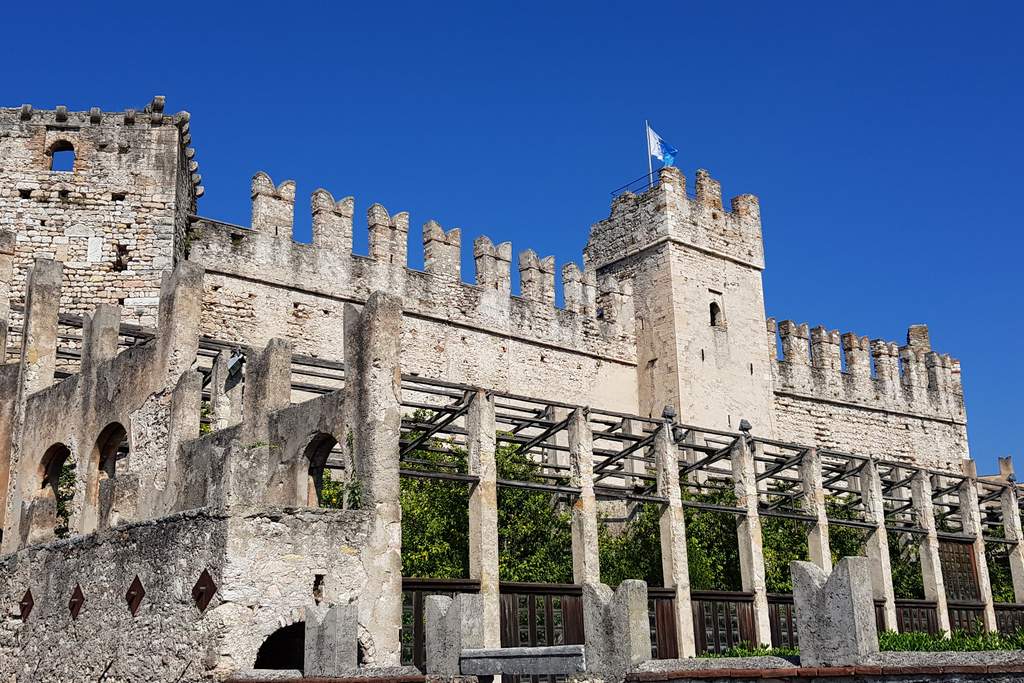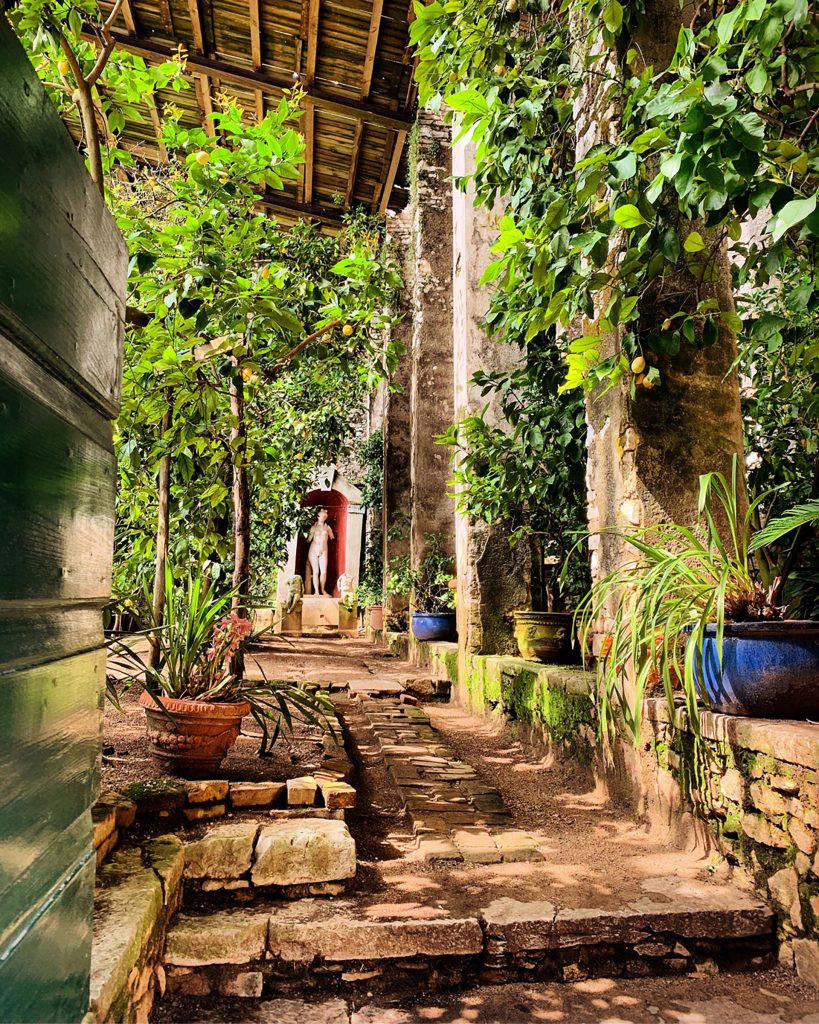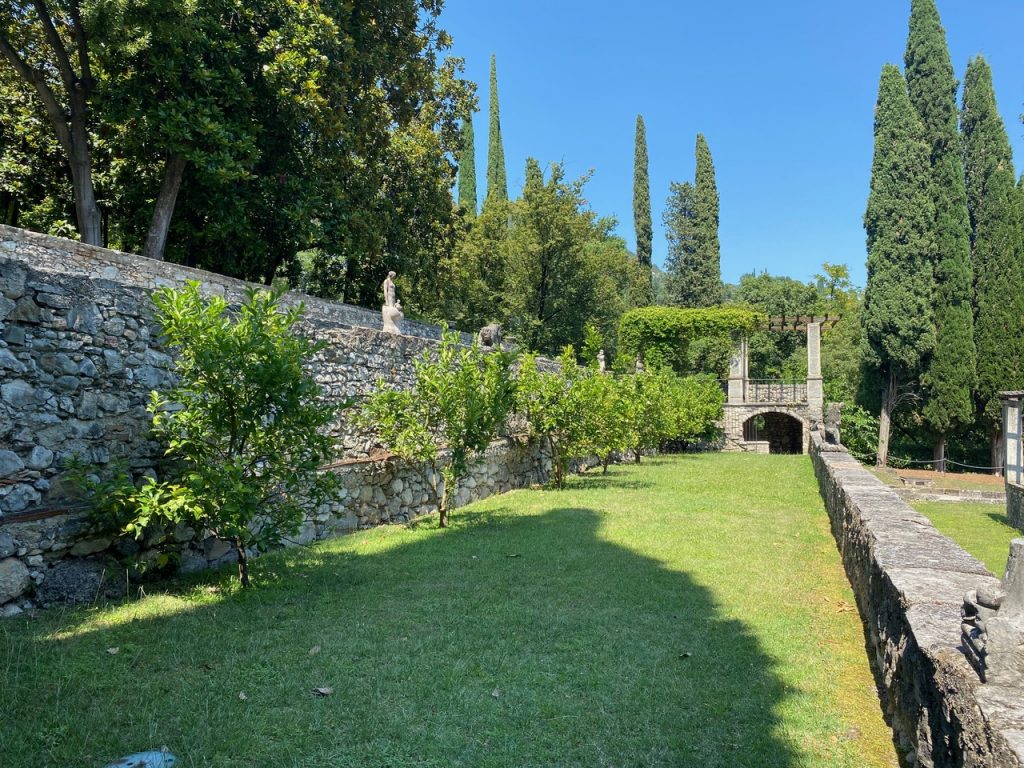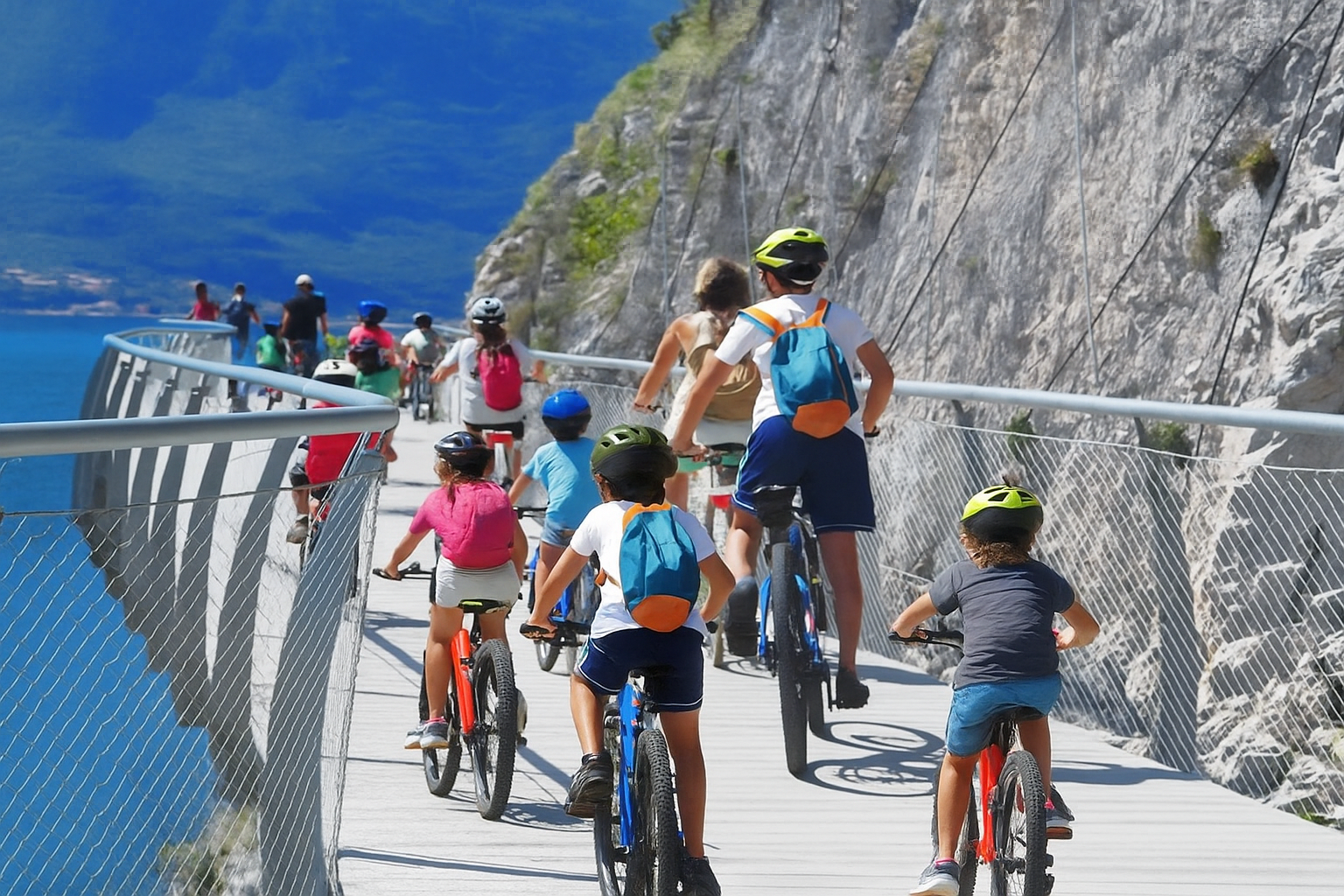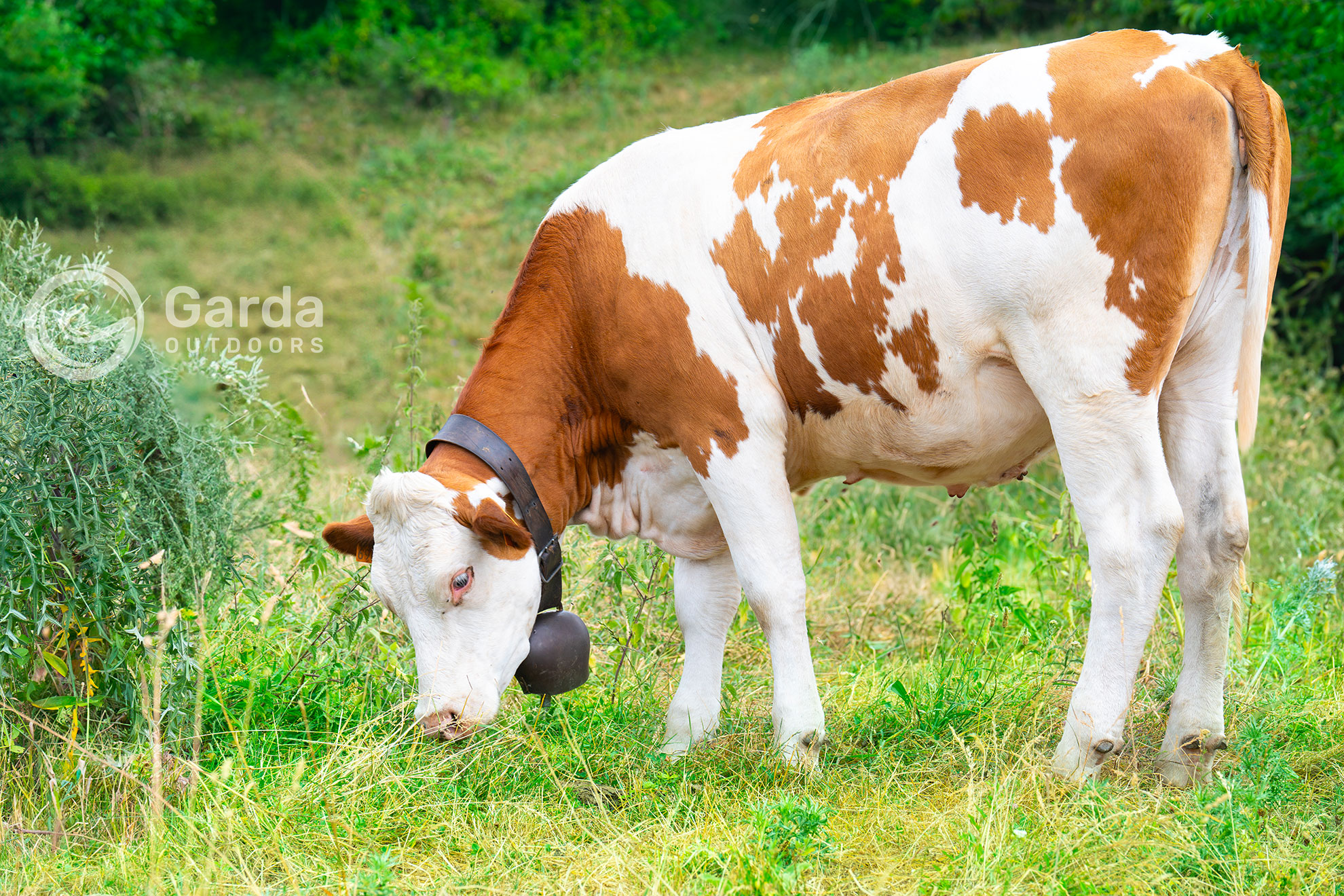Lake Garda, with its 46° north latitude, represented in the past the northernmost area in the world where citrus fruits were cultivated for commercial purposes. This is due to its Mediterranean climate, which reconciles the growth of these precious fruits.
This is why, passing along the road that runs along the western shore, you will notice the terraces that house the lemon houses, with the typical colonnade that almost mystifies them in a sort of Pantheon.
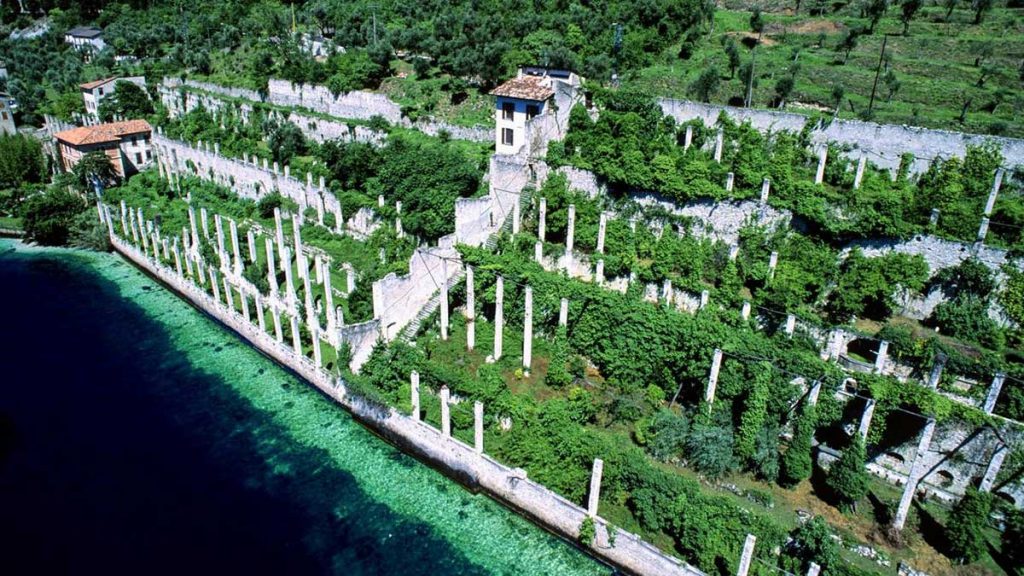
When did the lemons and citrus fruits arrive on Lake Garda?
Since the early 1600s they have come from the Ligurian Riviera and have found their place especially on the western shore of Lake Garda. This is because it enjoys more sunlight in the morning, as it is illuminated first. One of the testimonies is found in the rectory of Limone sul Garda: a painting from 1658 depicting Sant’Antonio Abate, with the pillars of the lemon groves in the background
But already in the mid-1400s some writers wrote about the “leafy branches of lemons and cedars” near Gargnano and it seems that the friars cultivated the first citrus fruit gardens right there.
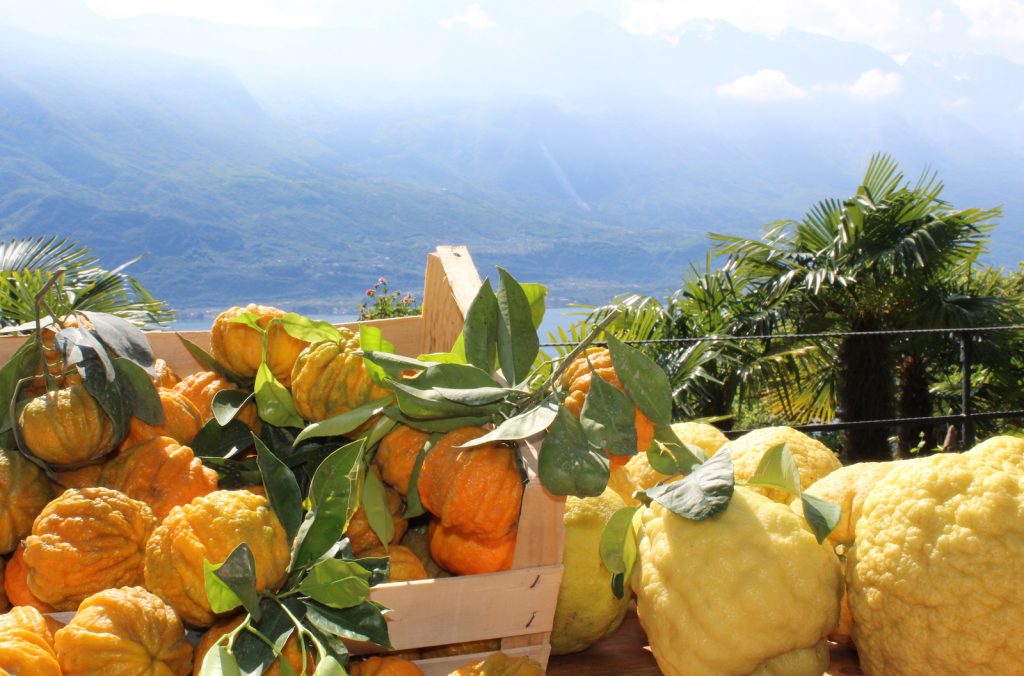
How is a lemon house structured?
These are semi-closed terraces on three sides, often made with stone walls, connected to each other by ladders, and facing south-east to ensure maximum exposure to the sun.
Each terrace is scattered with columns that serve as a support for wooden or glass plates that protect the plants during the winter (November to March) as in a greenhouse, here called còla. In the past, to heat citrus groves it was also necessary to light fires when temperatures became too prohibitive for the health of the plants.
To collect the precious fruits, you went up on special steps and placed them in leather bags and then in large containers suitable for transport by boat. Flowers were also sold, to eat them or extract their aroma, perfumes, candied peels, juices and jams were produced, and they were used to make medicines and essences.
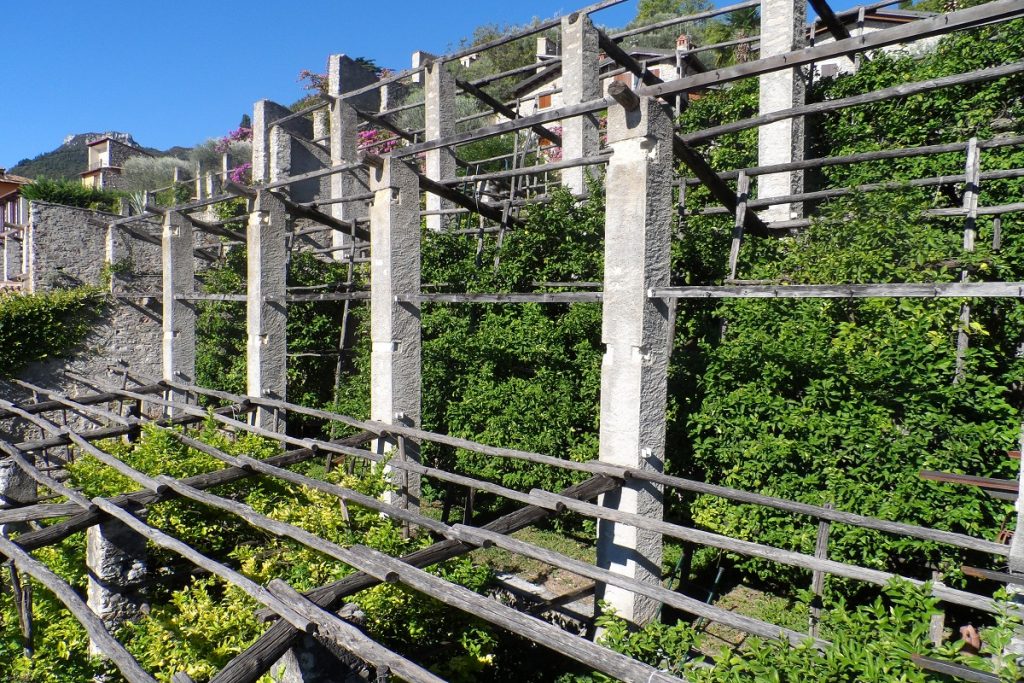
Historical notes on lemon groves.
A plant in full operation can supply 2 -3,000 lemons in a year: these, once peeled, were in the past selected and divided according to their thickness, wrapped and then arranged in wooden crates, ready to be taken to the ports of Torbole, Bardolino or Desenzano, from where they took the road to northern Europe (Germany, Hungary, Poland and Russia), Venice or Milan.
They were in great demand because they enjoyed shorter transport costs and times than lemons from Southern Italy and Liguria. Not only that, the production was of superior quality, with larger fruit, thin rind and greater durability.
Historically, the production of citrus fruits for export was mainly lemons, while sweet oranges (Portuguese) were destined for local consumption. The cultivation of cedars is also interesting and consistent from which in the nineteenth century fine liqueurs were obtained produced in various local distilleries (famous in Gargnano the Paccagnella and the Samuelli), but which in the past were mainly sold to the large Jewish community established since the sixteenth century in Mantua who needed fresh cedars for the religious ceremony of the Tabernacles.
The citrus fruits of the upper Garda also included bitter oranges which – given their greater resistance to frost – often also grew outside the perimeter of lemon groves and were cultivated more as rootstocks than for fruit.
In the second half of the nineteenth century signs of crisis appeared, first for the gummy disease (1855), then for the competition of the lemons of the southern regions following the Italian unification (1861) and the development of transport, finally for the discovery of synthetic citric acid. All these factors made cultivation less and less profitable; the Great War, with the requisition of the roofing materials of the gardens, and the exceptional cold of the winter of 1928-29 gave it the definitive blow.
Thanks to the advent of tourism, an economic sector of primary importance for the area, today some lemon houses have been renovated and made open to visitors to testify to their history and cultural importance.
The list of the most beautiful lemon houses on Lake Garda.
The Limonaia del Castel in Limone sul Garda (BS).
From the center of Limone sul Garda just follow the beautiful tiles set among the cobblestones, which will guide you step by step to this suggestive lemon house, from which you can enjoy a breathtaking view of the town and the lake
The Municipal Administration, with the intention of enhancing this heritage, bought the “Limonaia del Castèl” in 1995, renovating it and putting it back into use, with the planting of over a hundred citrus fruits, the restoration of the terraces and the irrigation system, the arrangement of the tool sheds, which have also become an educational path.
OPEN EVERY DAY FROM MAY 1 TO OCTOBER 31 AT THE FOLLOWING TIMES:
From 1st to 31st May, and from 1st to 31st October: 10:00 🕙 ↦ 17:00 🕔
From June 1st to September 30th: 10:00 🕙 ↦ 22:00 🕙
For more information, or for reservations, simply contact the Town Hall during office hours, on +39 0365 954720.
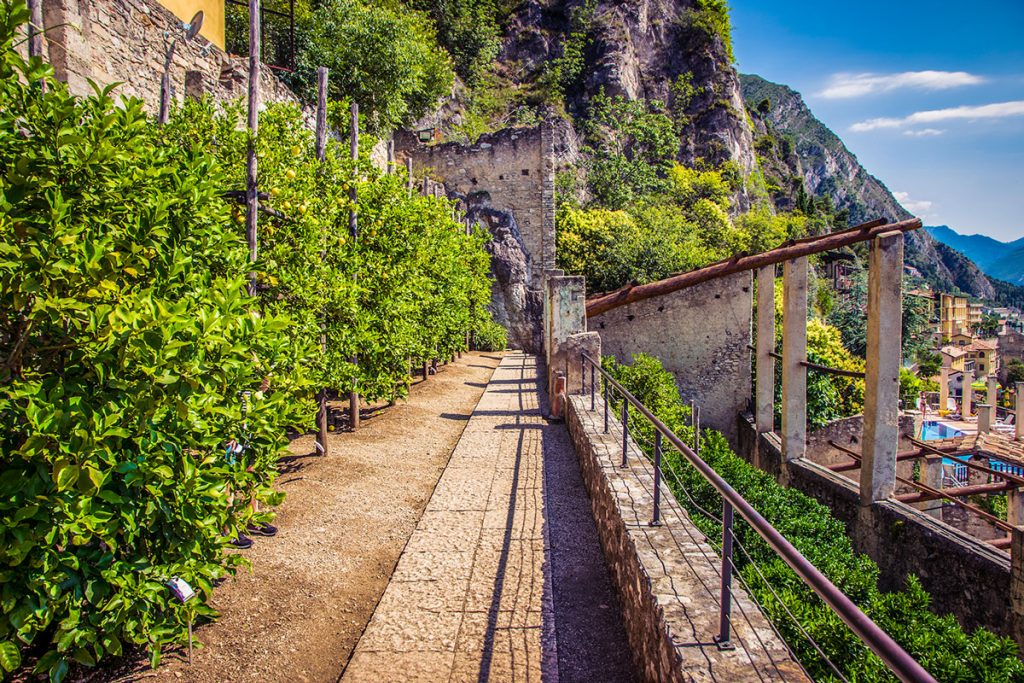
Also in Limone sul Garda you can find two other lemon houses:
The Limonaia del Tesol (Tesöl), located a couple of kilometers from the center of Limone, at the foot of Mount Preàls. Its eighteenth-century lemon garden passed in ownership around 182 from the Bertelli family to Count Giacomo Ferrari.
And the Limonaia of Villa Borghi, at the beginning of the town, located in the large park (open to the public every day from 9:00 to 20:00), where you will also find olive trees, cypresses, palm trees and exotic plants.
Prà de la Fam in Tignale (BS).
Prà de la Fam is a splendid gulf that appears when you least expect it, where the Garda road makes a curve and the lake with the sheer rock creates an incredible glimpse. You will find a beautiful beach very popular with windsurfers and the historic lemon house clinging to the mountain.
The Pra dela Fam lemon house was recovered by the Mountain Community in 1985: three terraces of the eighteenth-century citrus garden with explanatory papers and historical photographs are open to the public, and it is also possible to buy typical local products. For info and visits click here.
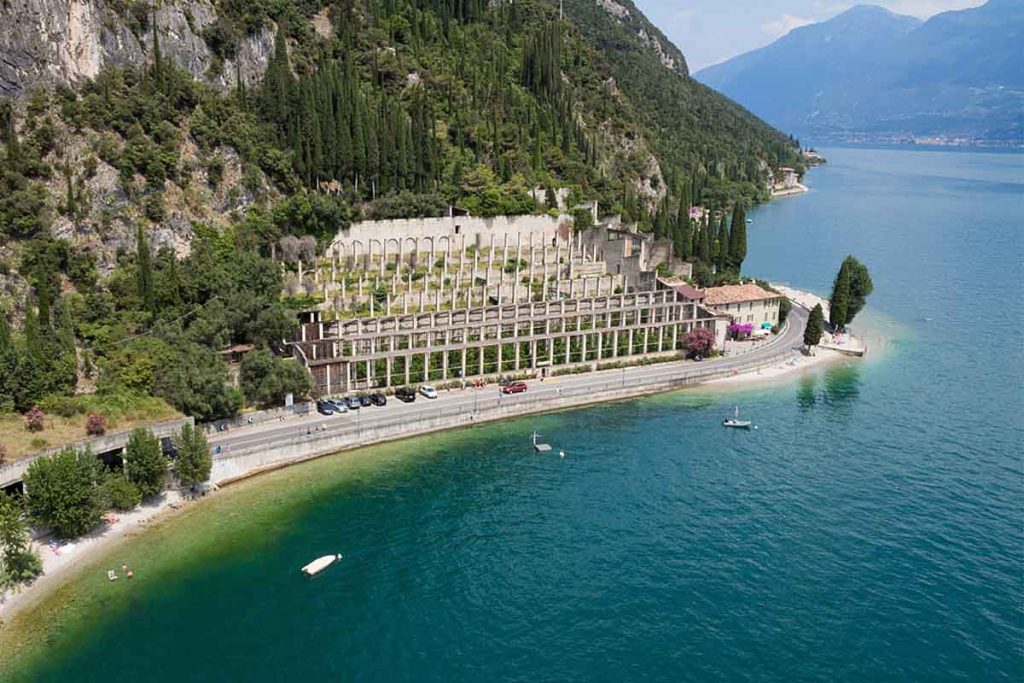
Limonaia “La Malora” in Gargnano (BS).
Located on the slope of a hill overlooking the lake, the lemon house for five centuries has continued to produce lemons in full efficiency and in perfect condition thanks to the care and dedication to native plants (including the Madernina lemon, the rare cedar of Salò used in the production of the precious cedar water, the lunario lemon), some of which are centenary.
It is possible to visit this lemon house independently, following a path between the ancient structures and learn about the roofing technique, the particular irrigation system, the mill wheel, the toll booth with the ancient work tools. For info and visits click here.
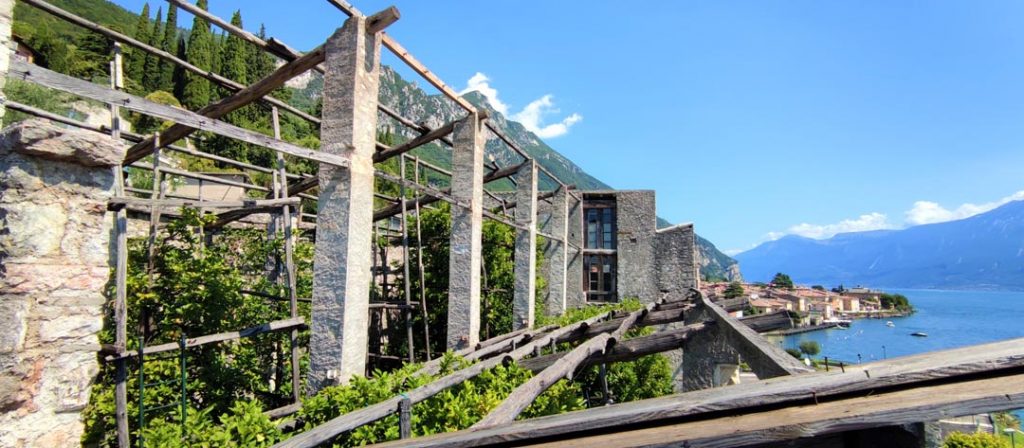
In Gargnano, moreover, in the month of April the “Citrus Gardens” event takes place, because there are many lemon houses managed by private individuals or public bodies, which open their doors for the occasion and show the rarest varieties of these fruits.
The lemon greenhouse at the Scaligero Castle in Torri del Benaco (VR).
Access to this greenhouse, one of the few left on the east coast, is made possible by visiting the beautiful Scaligero Castle in Torri del Benaco. You enter via a wooden bridge, suspended over a large pool, now used as a pond, but once used as a water reserve for irrigation. The water was distributed to the plants through tuff channels, from where, with the help of two axes placed at right angles, the water was made to flow at the base of the plants. Each of these enjoys an area of about 20 square meters, called field or span, between one pillar and the other: this applies to lemons and oranges; near the windows we find the cedars, arranged in an espalier, and some mandarins. The lemon trees, which can reach 7-8 meters in height, are supported by long chestnut antennas, fixed at the top of the cantér: these antennae are not stuck in the ground so as not to damage the numerous small surface roots. For info and visits click here.
In the Verona area, another lemon house is that of Villa Brenzoni in San Vigilio (Garda – VR). For info click here.
The lemon houses in Pieve di Tremosine (BS).
One built at the end of the nineteenth century, as a small garden and a small castle, soon fell into a state of neglect. Another larger lemon house is located in Campione di Sopra, a hamlet of Tremosine sul Garda, perhaps built at the beginning of the eighteenth century.
The lemon house in Toscolano Maderno (BS).
Recently restored by the Municipality, this seventeenth-century lemon house is located in the current Piazzale Salvo D’Acquisto. A small part of this lemon house remains next to the supermarket; it is one of the many lemon houses visible from the port, which were once active.
The lemon houses in Gardone Riviera (BS).
One is located next to the Church of San Nicolò di Gardone Sopra, dates back to the early twentieth century as part of Villa Elena, and has been restored by the municipality in the last 15 years.
Another lemon house is part of the Prioria gardens at the Vittoriale degli Italiani, the residence of the poet Gabriele D’Annunzio. For info and visits click here.
Cedar of Salò, a citrus fruit of excellence on Lake Garda.
In Salò it is possible to taste the ancient Salodian fruit par excellence: Citrus Medica, better known as Cedar of Salò.
Originally from the Garda town and later spread to other areas of Italy, in particular in the Ligurian Riviera di Ponente where it is called “cedrino”; after years of decline on the coasts of Benaco due to the crisis of the mid-nineteenth century, the nurseryman Tiziano Giacomini managed to bring the fruit back to its land of origin. Having found the Cedro di Salò in two manor houses between Menton and the provinces of Savona and Imperia, Mr. Titian cut three slips by grafting them on some bitter orange plants. A successful graft that after several years and various organoleptic tests performed by the Istituto Pastori of Brescia led to the obtaining of a passport and certification: the Cedro di Salò is officially back on the soil of Salò and Benacense!
This cedar gave rise to the Salò liqueur and to the renowned factories that produced cedar water, including Cedrinca and Cedral Tassoni (which still produces the much appreciated and famous Cedrata). Being able to reproduce it is an operation of great historical value.
Were you inspired by the history of the lemon groves and the Cedro di Salò? I think how good a simple cake loaded with lemon zest grated in the dough is, and how fragrant your hands remain after preparing it.
Hotels – Restaurants – Experience on Lake Garda.
On Lake Garda there are many facilities in which to stay, from small and well-kept B&Bs to resorts with wellness centers and beauty services. In the section dedicated to hotels on Lake Garda, you will find all the information you need to find the most suitable accommodation for you.
The same goes for restaurants, at this link you will find our selection of restaurants on Lake Garda. Remembering that Lake Garda offers several starred restaurants and the quality of the culinary offer is very high.
There are many activities and experiences you can do on Lake Garda, so we recommend that you visit the section dedicated to experiences in our magazine by clicking here.
For any questions about Riva del Garda or about your holiday on Lake Garda, do not hesitate to contact us by commenting on this article or by writing on our social channels (Instagram, Facebook, Twitter, TikTok), we are always available to help you.
See you next time dear Outdoors!
Silvia Turazza – Garda Outdoors editorial staff
